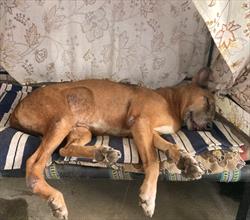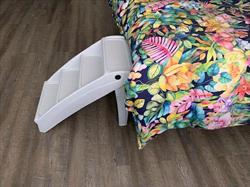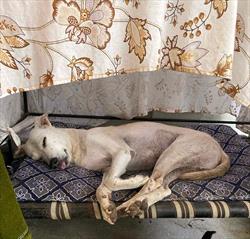Big Brownie

Photo Courtesy Asiya Bhaisaheb, Veterinary Student Class of 2025
The goal of hospice care, sometimes referred to as palliative care or end-of-life care, is to improve comfort at the end of your pet's life. Some diseases are incurable or would involve uncomfortable or expensive treatments that your family may choose not to pursue. Even so, there are still simple steps you can take to make your pet comfortable and peaceful. With hospice care, you can help them enjoy life as much as possible until their time comes.
How Do I Know if Hospice Care Is Right for My Pet?
If your pet's condition has progressed to the point where curative treatment is no longer your first choice, you can talk to your veterinarian about hospice care. They can discuss the symptoms your pet has, what you can expect for your pet's health as time goes on, and options for care. It is best to bring everyone in your household who will be involved in caring for your pet to this discussion. There may also be house-call veterinarians focused on end-of-life care in your area who will have further information for you. You may have to search for these house-call veterinarians online if you want to pursue that type of care.
At this consult, your veterinarian may ask you what your goals are for hospice care, what you want your pet's end of life to look like, and what your thoughts are about euthanasia. Consider your ability to give regular medications, modify your home, or spend more time with your pet during hospice care. Some conditions may also require advanced care at home, such as daily injections, and specialized diets possibly including tube feedings, skin dressings, and enemas. Some pet owners are unable to provide the level of care that hospice requires. If that is your situation, let your veterinarian know. Hospice is about finding what you feel is the most comfortable end of life you can offer your pet.
How Could Hospice Care Make My Pet More Comfortable?
Your veterinarian will discuss some options for pain management with you. They may prescribe pain medications or recommend additional treatments, such as acupuncture, massage, physical therapy, or temperature therapy (the use of heating or cooling devices to soothe pain). They may also offer medications for nausea and anxiety, two other common symptoms in dying patients. Hospice care may also involve regular laboratory tests to make changes as necessary for your pet's comfort. For example, regular blood tests in animals with kidney failure can help to identify changes in blood chemistry. You and your veterinarian can then decide what is best for your pet and their quality of life.
What Is My Role as a Caregiver in Hospice Care?
Your job is to spend as much quality time with your pet as you would like, give medications and treatments if necessary, and monitor their health at home. Some end-of-life veterinarians have team members who can help you give these treatments if necessary. You may also need to maintain your pet's hygiene with a damp cloth or wet wipes, especially if their mobility is limited or they are incontinent, as urine and stool can lead to skin irritation. Discussing any issues that come up with your veterinarian so you can address them quickly together is also part of your role. Pet owners often share with veterinarians how special it is to care for their pets during their final days of life.
What Will I Need To Change in My Home?
Dog Steps

Photo courtesy Dr. Teri Ann Oursler
You may want to make some temporary changes to your home to ensure your pet's safety and comfort.
- If mobility is limited, you can lay down rugs with a non-slip rubber backing.
- Stairs should be blocked off or used only under supervision to prevent accidents.
- Raising food and water beds up to shoulder level allows pets to use them in a more comfortable position.
- Use soft, easily cleaned bedding. It may be useful to have multiple sets so that they can be easily changed out. Avoid covering bedding with plastic to waterproof it as this may make it too warm. A better choice for waterproofing can be a rug with rubber backing or a baby crib sheet.
- If your pet normally climbs on couches or beds, steps or ramps with a gentle incline will allow them to safely get on and off furniture.
- Keep water and litter boxes close to your pet’s bed for easy access.
- Remove or lower the walls of litter boxes to make them easier to enter.
- Create quiet places in the home where pets can take naps away from busy areas.
How Can I Check My Pet’s Quality of Life at Home?
Checking your pet's quality of life is a way of weighing the factors that improve their lives against those that make it more difficult. As your pet's owner and the person who knows them best, you are well equipped to perform quality of life assessments by observing them at home. Regularly ask yourself these questions:
- Does my pet seem playful, energetic, and happy, or dull and depressed?
- Does my pet have more good days than bad?
- Does my pet eat their normal amount of food? Do they accept treats and special/favorite snacks?
- Is my pet able to keep themselves clean?
- Is my pet able to move around? Do they lay in the same place all day?
- Does my pet seem painful? Is there excessive panting, trembling, or crying?
By keeping track of your responses, you can monitor any changes in your pet's wellbeing and work with your veterinarian to keep them comfortable for as long as possible
There are a variety of other quality-of-life scoring systems and tools available online. You can use these tools to assess your pet’s quality of life, follow their progression, and think about what you want your pet’s end of life to look like. Each of these systems has its own benefits and drawbacks, and one might fit your situation better than another. Whichever scale you choose, use it consistently so that you can accurately track changes in your pet’s quality of life.
https://veterinarypartner.vin.com/doc/?id=4951966&pid=19239
https://vetsocialwork.utk.edu/wp-content/uploads/2016/03/EndoLifeValues-Goals.pdf
https://vet.osu.edu/vmc/sites/default/files/import/assets/pdf/hospital/companionAnimals/HonoringtheBond/HowDoIKnowWhen.pdf
White Brownie

Photo Courtesy Asiya Bhaisaheb, Veterinary Student Class of 2025
Where Can I Go for Support?
Your veterinarian and veterinary staff are available to help you understand the process of end-of-life care. If necessary, they can also refer you to other professionals who can help you, like pet sitters, groomers, veterinary technicians, or veterinarians who specialize in certain diseases. Consider reaching out to a bereavement or grief counselor, as many will hold pet loss groups or classes that you can attend for as long as you feel you want to go. You may also find it comforting to turn to spiritual leaders.
Providing hospice care can be difficult, so remember to take care of yourself as well by seeking support from friends, family, and professionals when you need it. Be sure to get enough rest and make time for activities that bring you peace and joy. Your love and care will have a huge impact on your pet’s comfort at the end of their life.